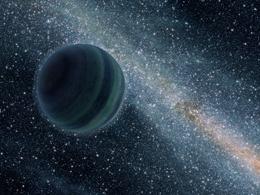Kepler has opened up the Universe for us with evidence that there are many more planets orbiting stars than we previously thought. The consequences of this is that the potential for life beyond Earth has grown exponentially. Recent news from a team of astronomers lead by Takahiro Sumi from Osaka University in Japan and published in the journal Naturehas revealed that there may be as many as 400 billion planets roaming the Milky Way Galaxy, free from their parent stars.

This discovery was made by using a technique called gravitational lensing or microlensing in this particular case. According to Einstein’s General Theory of Relativity, the gravitational field of a massive object will bend light that passes through it. This technique has been used to view distant galaxies that are behind an intervening large cluster of galaxies, which magnify and distort the image of the more distant objects.

In the case of gravitational microlensing, the intervening objects are these rogue planets and the distant objects are stars. The alignment of the star, planet and Earth is almost perfect, such that when the planet passes in front of the star its gravitational field causes the star to brighten and dim in a predictable fashion. This is a brief event and will not repeat itself.
These objects are similar in mass to Jupiter. And, if they are truly planets or possibly brown dwarf stars (small stars that generate heat but are too small to trigger the fusion process to burn brightly), they may have been ejected from their solar system of birth through the normal dynamics that force a solar system into a stable state. Interestingly, this challenges the definition of planet, which was decided upon by the International Astronomical Union (IAU) and led to Pluto’s demotion to dwarf planet, but that is a a discussion for another blog.
The objects detected are fairly massive, which begs the question: What about smaller Earth-like planets? Can we see them and how many of them are there out there? As usually happens in the world of astronomy, discoveries bring more questions than they answer.
The discovery of these objects challenges the current theories of planetary evolution and possibilities for life in the Universe. More research in this area will be conducted when NASA’s Wide-Field Infrared Survey Telescope (WFIRST) is launched, allowing for the faster blips of light to be detected, indicative of Earth-mass type objects.
Till next time,
RC Davison
